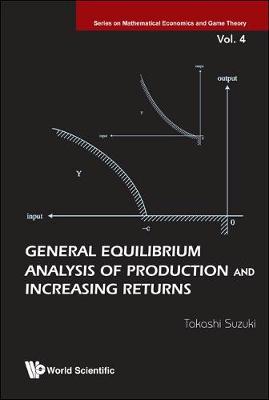Series On Mathematical Economics And Game Theory
2 primary works
Book 4
General Equilibrium Analysis Of Production And Increasing Returns
by Takashi Suzuki
Published 5 June 2009
The scope of the general equilibrium (GE) theory has so far been limited to the Walrasian tradition. Indeed, the theories of competitive equilibria and the core are nothing but the modern mathematical analysis of the economic ideas due to Walras, Edgeworth and Pareto. Consequently, recent books in this field are inclined to be heavily technical and mathematical.On the other hand, the modern GE theory has not completed the study of increasing returns and monopolistic competition, which belong to the alternative important stream of economic thought, namely the Marshallian tradition. This book aims to fill this gap, by proving the existence of a competitive equilibrium with increasing returns coming from externalities in a dynamic economy and a monopolistically competitive equilibrium with the technologies exhibiting increasing returns coming from a large set-up cost. Also intended as a basic graduate textbook on GE theory, it contains all the basic results and mathematical techniques in this field, such as measure theory, manifold theory and Banach space theory.A unique feature of the book compared to classical monographs on GE is its emphasis on the historical nature of the subject, and not only the mathematical nature. Students are expected to learn that those mathematically formidable techniques are indeed necessary for tackling many economic problems which have been significant not only in the mathematical or technical context, but also in the historical and traditional context.
Book 6
The aim of this book is to incorporate Marshallian ideas such as external increasing returns and monopolistic competitions into the general equilibrium framework of Walrasian tradition. New chapters and sections have been added to this revised and expanded edition of General Equilibrium Analysis of Production and Increasing Returns (World Scientific, 2009).The new material includes a presentation of equilibrium existence and core equivalence theorems for an infinite horizon economy with a measure space of consumers. These results are currently the focus of extensive studies by mathematical theorists, and are obtained by an application of an advanced mathematical concept called saturated (super-atomless) measure space.The second major change is the inclusion of a simple toy model of a liberal society which implements the difference principle proposed by J Rawls as a principle of distributive justice. This new section opens up a possibility to connect theoretical economics and political philosophy.Thirdly, the author presents the marginal cost pricing equilibrium and discusses welfare properties of the external increasing returns, which also belong to Marshall/ Pigou tradition of the Cambridge school.Finally, a new mathematical appendix treats basics of singular homology theory. Although the fixed point theorem is originally a theorem of algebraic topology, most economic students know its proof only in the context of the differentiable manifold theory presented by J Milnor. Considering the significance of the fixed point theorem and its playing a key role in general equilibrium theory, the purpose of this new appendix is to provide readers with the idea of a proof of Brower's fixed point theorem from the 'right place'.This volume will be helpful for graduate students and researchers of mathematical economics, game theory, and microeconomics.

